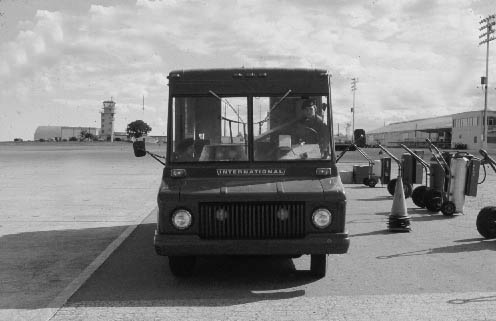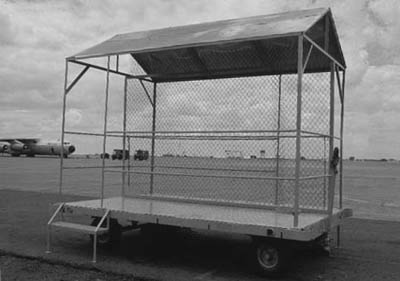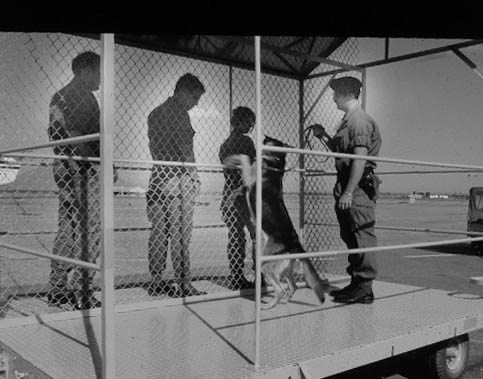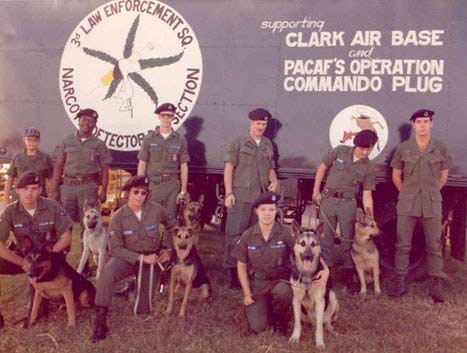The drug culture of the 60's and 70's also affected the military. In South-East Asia illegal drugs were readily available for illicit use and trade. Heroin, marihuana, and hashish were of very high strength (and very cheap) compared to the drugs available in the US. Attempts to smuggle drugs became common as troops rotated home from tours. Stringent customs inspections were initiated as the first prevention step. It soon became apparent, that some military members were attempting to develop smuggling rings and that military aircraft were being used. In the early 70's, the use of drug detector dogs became common at all South-East Asia (SEA) and PACAF bases. Drug dog teams searched all outgoing aircraft, luggage, mail, and military equipment. When the Thailand bases were closed, handlers from Korea and Japan were sent to help with the massive searches of equipment being removed. Drug dog teams often made dramatic and sometimes very large seizures. The decision was made at PACAF Headquarters to develop a comprehensive drug suppression program. This program was given the name "Operation Commando Plug" (the military name game strikes again). Procedures were developed to ensure that all aircraft would be carefully searched by drug dog teams as part of the required customs clearance. The drug suppression program evolved into mandated dog searches of postal facilities, barracks, work areas, shops, etc. as a monthly requirement. Many bases organized their drug dog teams into section, separated from their patrol dogs. At Clark Air Base, RP the drug dog handlers even became certified as customs inspectors. This allowed them to complete all of the customs clearance requirements. In the early to mid 70's, drug use by military members was not condoned but it was not viewed to harshly by some unit commanders. Airmen in critical career fields would not be removed by transferring to another job specialty. In some cases it took multiple drug busts. A simple drug bust usually ended in a verbal counseling or a letter of counseling (a letter placed in the airman's records) from the unit commander. This contrasted sharply with the stricter discipline requirements of the Security Police career field. I remember one instance at Clark AB, where the Law Enforcement Squadron Section Commander wanted to issue a letter of reprimand to a Drug Dog Flight Chief. He had lost a single 38 revolver round. I reminded the captain, of the discipline actions that I had observed by commanders for drug busts. Drug dog alerts established probable cause to believe that illegal drugs were present. The base commanders could authorize a search of any property located on base. This is the civilian version of a search warrant from a judge. In order for the search to withstand an appeal, the base commander had to be familiar with the dog's performance. Handlers would document daily training and the dog's find rate (batting average) was calculated. The documentation had to be carefully maintained. Dogs could inspect the common areas of barracks (halls, day rooms, and the exterior of doors to the individual rooms assigned to the occupants of the barracks), etc.) without a search warrant from the base commander. If a dog alerted on the door to an airman's room, then a search warrant was requested (and required for the search to be admissible) from the base commander. Handlers were required to search (inspect if you want to be picky) all barracks at least once a month. Work area searches did not require search authorization (unless the dog alerted on a private locker). Small dogs were also used to search aircraft and other confined areas. See the History of Military Dogs in PACAF Handlers became very familiar with points of law referring to search and seizure. The constitutional safeguards allowed to all US citizens was applicable to all military members even overseas. However, this only applied to where the military had jurisdiction. At some PACAF bases, the host nations had a very sever outlook on drug use. Some military members discovered that our constitutional safeguards did not apply to the local government. For instance, in the 70's Japan had a very strong aversion to drug use. Any American military member found in possession of a small amount of marijuana would face years in a Japanese prison. The Japanese legal system has more than a few differences; for example: (1) The accused is considered guilty and has to prove his innocence. (2) There are no requirements for search warrant or for searches to be legal. The Status of Forces Agreement between our government and Japan allowed the Japanese to have criminal jurisdiction over servicemen charged with some crimes. In several cases of possession of small amounts (under 1 ounce of marijuana) Americas servicemen were sentenced to several years in a Japanese prison. It was often reported that Japanese prisons did not have the amenities that American prisoners expected. In the 1979 or 1980, the rock band Wings was scheduled for a tour in Japan. While clearing customs at Narita International Airport, Tokyo, Japan, Paul McCarthy was arrested for possession of several ounces of marijuana . He was in jail for several days, while the Japanese government determined what to do with an international personality. Interesting enough, the Japanese government freely admitted that he was receiving what they considered preferential treatment. They specifically used the term preferential treatment. The preferential treatment he received was to have bread & water, instead of rice and green tea for meals. Instead of being sentenced to several years, he was deported after a few days. The practice of drug defendants receiving long prison sentences was changed after that.
Photo Above: At Clark Air Base, Republic of the Philippines had a 28 dog team section used to fulfill the Commando Plug requirements. The section used special metro vans to transport dog teams. The vehicles had been customized by adding cages and additional seating. Passengers scheduled to depart on the contracted civilian passenger aircraft received a special screening. They stood at a screen inside the terminal, before boarding. Fans were mounted on the wall to create air currents from the line of passengers, through the fence, to the dog. A dog could stand on the fence and search for the distinct odors of the drugs. The fence removed any danger of dog bites. All hand carried items and checked luggage was also searched by the other dog teams. Several dog teams were committed for processing passenger planes. Passenger aircraft departing required special procedures. Aircraft holding areas were secured using methods similar to safeguarding nuclear weapons. A restricted area was set up around the aircraft using a portable rope barricade. An entry control point (ECP) was designated and manned by a drug dog team. Usually this would be one of the special vehicles used to transport dog teams. All equipment, supplies, and vehicles entering were searched by a drug detector dog. Even fire extinguishers were checked.
A portable screen (above) was pulled to the ECP at the aircraft holding area. The chain link fence removed the danger of dog bites and the dog could alert on drugs hidden on the person. All personnel had to stand at the screen while being sniffed be a a drug detector dog. . This included both military and civilian aircrews. This cordon was maintained until the aircraft taxied for takeoff. Photo Below: Portable Screens at Clark Air Base, RP
Above: Screen in use.
Photo Above: Narcotic Detector Dog Section (Day Shift) Clark AB, RP. The Flight Chief was a young SSgt John Probst (later to be Col. John Probst). |





